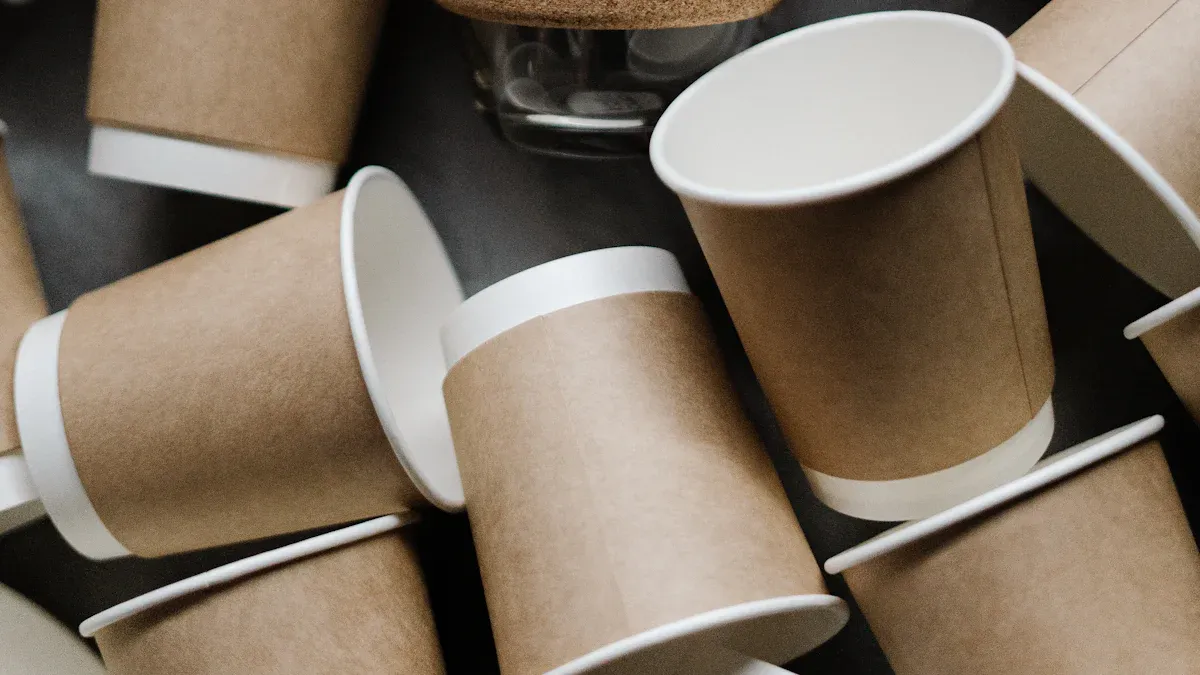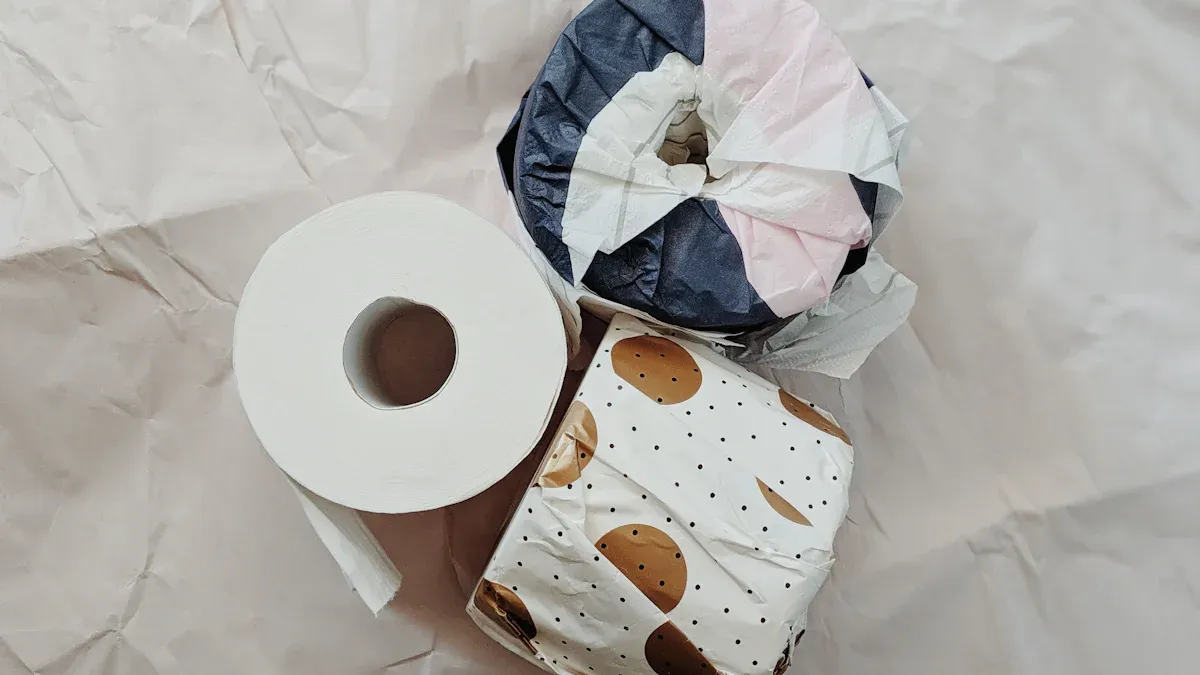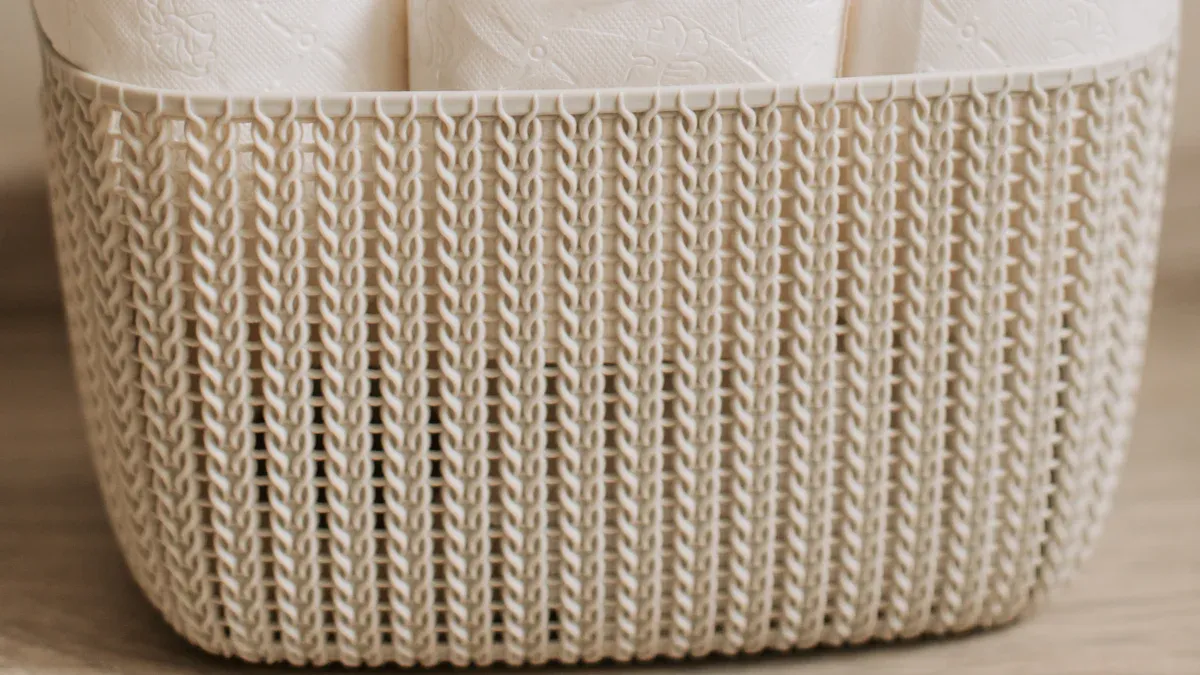
Sustainable tissue roll materials, including bamboo and recycled paper, help reduce environmental harm. Unlike virgin wood pulp, which relies on freshly cut trees, these materials minimize deforestation and carbon emissions. For example, duplex board production generates 1,848.26 kg of CO2 equivalent, while folding boxboard emits 2,651.25 kg—highlighting the environmental advantages of sustainable options. Practical factors like softness, affordability, and the raw material for making toilet paper also affect consumer choices. Companies such as Ningbo Tianying Paper Co., LTD. play a key role in providing diverse tissue roll material solutions, from jumbo roll virgin tissue paper to napkin tissue raw paper, catering to various needs.
Understanding Sustainable Tissue Roll Materials

Bamboo Tissue Roll Material
Bamboo tissue roll material has emerged as a sustainable alternative due to its remarkable environmental benefits. Bamboo cultivation requires minimal resources, relying solely on natural rainwater and eliminating the need for artificial irrigation. Its rapid growth rate and ability to regenerate from its roots make it a renewable resource that does not require replanting. Additionally, bamboo’s root system prevents soil erosion, contributing to healthier ecosystems.
The production process for bamboo tissue rolls also demonstrates a lower carbon footprint. Bamboo travels short distances, often less than 5 kilometers, from forest to factory, reducing transportation emissions. Studies show that bamboo harvesting and processing result in significantly fewer carbon emissions compared to both recycled and virgin wood pulp tissue rolls. For instance, families switching to bamboo tissue rolls can save up to 74 kilograms of CO2 emissions annually. Furthermore, regularly harvested bamboo acts as a carbon sink, sequestering carbon while releasing oxygen into the atmosphere.
Recycled Tissue Roll Material
Recycled tissue roll material offers another eco-friendly option by repurposing post-consumer paper waste. This approach reduces the demand for virgin wood pulp, directly supporting reforestation efforts and minimizing deforestation. Recycled tissue rolls typically contain over 80% recycled material, maximizing sustainability while optimizing cost efficiency.
The environmental impact of recycled tissue rolls is evident in their reduced carbon footprint. Lifecycle assessments reveal a 15-20% decrease in emissions per unit compared to virgin wood pulp products. Additionally, the production process emphasizes energy efficiency, with annual improvements of up to 15%, and waste reduction, achieving a 10-12% decrease in production waste. These metrics highlight the commitment of manufacturers to sustainable practices.
Recycled tissue rolls also align with consumer preferences. Surveys indicate that over 85% of customers express satisfaction with the quality and sustainability of these products. This positive feedback drives continuous innovation and reinforces the importance of recycled materials in the tissue roll industry.
Exploring Virgin Wood Pulp Tissue Roll Material

Manufacturing Process of Virgin Wood Pulp
The manufacturing process of virgin wood pulp begins with harvesting trees from managed forests. These trees are debarked and chipped into small pieces, which are then cooked in a chemical solution to separate the cellulose fibers from lignin and other impurities. This process, known as pulping, produces a slurry that is washed, bleached, and refined to create high-quality pulp. The pulp is then dried and pressed into sheets or rolls, ready for conversion into tissue roll material.
Modern mills often incorporate advanced technologies to improve efficiency and reduce waste. For example, closed-loop water systems recycle water used during production, minimizing freshwater consumption. Additionally, energy recovery systems capture heat generated during the pulping process, reducing overall energy demands. Despite these advancements, the production of virgin wood pulp remains resource-intensive, requiring significant amounts of water, energy, and raw materials.
Environmental Impact of Virgin Wood Pulp
The environmental impact of virgin wood pulp production is substantial. Harvesting trees for pulp contributes to deforestation, which disrupts ecosystems and reduces biodiversity. The pulping process also generates greenhouse gas emissions, primarily from the energy-intensive chemical treatments and transportation of raw materials. Research shows that life cycle assessments (LCA) consistently demonstrate higher emissions for virgin pulp-based products compared to recycled alternatives. For instance, greenhouse gas emissions from recycled paper-based products are approximately 30% lower than those from virgin pulp-based products.
Another study comparing emissions from virgin and recycled paper products produced in the same mill found that virgin materials consistently resulted in higher environmental burdens. These findings highlight the need to prioritize sustainable practices and explore alternatives to virgin wood pulp. While virgin pulp tissue rolls may offer superior softness and strength, their environmental costs underscore the importance of adopting eco-friendly tissue roll material options.
Comparing Tissue Roll Materials
Environmental Impact Comparison
Sustainable tissue roll materials, such as bamboo and recycled paper, significantly reduce environmental harm compared to virgin wood pulp. Bamboo grows rapidly and regenerates naturally, eliminating the need for replanting. Recycled tissue rolls repurpose post-consumer waste, reducing the demand for fresh wood. In contrast, virgin wood pulp production contributes to deforestation and biodiversity loss.
Key Facts on Environmental Impact:
- FSC® certified forests still experience deforestation, with studies showing no difference in deforestation rates between certified and non-certified forest units.
- An estimated 12 million hectares of forestland are lost annually due to land use changes and rising demand for paper products.
- Canada’s boreal forest, a major source of virgin wood pulp, has the third highest rate of primary forest loss globally.
These statistics highlight the urgent need to prioritize sustainable alternatives. By choosing bamboo or recycled tissue rolls, consumers can help mitigate deforestation and reduce carbon footprints.
Health and Safety Considerations
Health and safety play a crucial role in selecting tissue roll materials. Bamboo and recycled tissue rolls undergo rigorous processing to ensure they meet hygiene standards. Manufacturers use eco-friendly bleaching agents, such as oxygen or hydrogen peroxide, to avoid harmful chemicals like chlorine. This process minimizes the risk of skin irritation and allergic reactions.
Virgin wood pulp tissue rolls, known for their softness, also meet safety standards. However, the chemical-intensive bleaching process used in some cases may raise concerns about residual toxins. Sustainable tissue roll materials, with their reduced reliance on harsh chemicals, offer a safer option for individuals with sensitive skin or allergies.
Cost and Practicality Analysis
Economic factors often influence consumer choices. Sustainable tissue roll materials, such as bamboo and recycled paper, provide long-term cost benefits despite higher initial prices. The following table outlines key cost-related factors:
| Factor | Impact on Costs |
|---|---|
| Fibre Costs | Alternative fibre sources can mitigate market pulp price fluctuations and improve cost efficiency. |
| Energy Costs | Investments in renewable energy sources can reduce reliance on fossil fuels and stabilize costs. |
| Manufacturing Efficiency | Improved technology can lead to reduced water and energy consumption, lowering overall manufacturing costs. |
| Availability of Materials | The shrinking availability of traditional virgin fibres complicates cost management for tissue producers. |
| New Fibre Sources | Investigating alternative fibres like grass and bamboo can provide cost savings and reduce exposure to price fluctuations. |
Virgin wood pulp tissue rolls often have lower upfront costs due to established supply chains. However, the shrinking availability of traditional fibres and rising energy costs may increase prices over time. Sustainable options, supported by advancements in manufacturing efficiency, offer a practical and eco-friendly alternative for cost-conscious consumers.
Choosing the Right Tissue Roll Material
Pros and Cons of Sustainable Tissue Roll Materials
Sustainable tissue roll materials, such as bamboo and recycled paper, offer numerous advantages but also come with certain trade-offs. These materials prioritize environmental preservation and align with consumer preferences for eco-friendly products.
Pros:
- Environmental Benefits:
Bamboo tissue rolls, for instance, rely on a renewable resource with a rapid growth cycle. Bamboo regenerates naturally without replanting, reducing deforestation and promoting ecological balance. Recycled tissue rolls repurpose post-consumer waste, minimizing landfill contributions and conserving natural resources. - Health and Safety:
Sustainable materials often undergo eco-friendly processing. Manufacturers use minimal chemicals, such as oxygen or hydrogen peroxide, ensuring safer products for individuals with sensitive skin or allergies. Bamboo’s natural antibacterial properties further enhance its appeal for hygiene-conscious consumers. - Consumer Preference:
Studies reveal that consumers prioritize quality and sustainability over price. Many buyers value the environmental benefits and ethical practices associated with sustainable tissue roll materials, leading to increased spending on these products. - Cost Efficiency in the Long Run:
Innovations like the Advantage™ DCT® technology improve manufacturing efficiency, reducing energy and water consumption. These advancements lower production costs over time, making sustainable options more accessible.
Cons:
- Higher Initial Costs:
Sustainable tissue roll materials often have higher upfront prices due to limited supply chains and specialized processing. However, long-term cost benefits may offset these initial expenses. - Softness and Durability:
While bamboo and recycled tissue rolls meet hygiene standards, they may lack the softness and strength of virgin wood pulp products. This trade-off can influence consumer preferences, particularly for premium-quality tissue rolls.
Pros and Cons of Virgin Wood Pulp Tissue Rolls
Virgin wood pulp tissue rolls remain a popular choice due to their softness and affordability. However, their environmental and health implications warrant careful consideration.
Pros:
- Superior Softness and Strength:
Virgin wood pulp tissue rolls deliver unmatched softness and durability. These qualities make them ideal for consumers seeking premium comfort and performance. - Established Supply Chains:
The widespread availability of virgin wood pulp ensures consistent supply and lower production costs. This accessibility contributes to their affordability in the market. - Advanced Manufacturing Technologies:
Modern innovations, such as the Advantage™ ViscoNip® press, enhance product quality while reducing energy and water usage. These advancements improve the practicality of virgin wood pulp tissue rolls for manufacturers and consumers alike.
Cons:
- Environmental Impact:
Virgin wood pulp production contributes to deforestation and biodiversity loss. The slow growth cycle of trees exacerbates resource depletion, with millions of trees harvested annually. In contrast, bamboo offers a more sustainable alternative due to its rapid growth and renewability. - Health Risks:
The chemical-intensive bleaching process used in virgin wood pulp production may leave harmful residues. Long-term exposure to these chemicals could pose health risks, including skin irritation and potential links to chronic illnesses.
| Aspect | Virgin Wood Pulp | Sustainable Materials (e.g., Bamboo) |
|---|---|---|
| Growth Cycle | Slow growth of trees | Rapid growth and natural regeneration |
| Environmental Impact | High deforestation and biodiversity loss | Minimal impact, promotes reforestation |
| Health and Safety | Potential chemical residues | Safer processing, antibacterial properties |
| Cost | Lower initial costs | Higher upfront costs, long-term savings |
Tip: Consumers can balance their priorities by choosing tissue roll materials that align with their values. Those prioritizing environmental sustainability may prefer bamboo or recycled options, while those seeking premium softness might opt for virgin wood pulp tissue rolls.
Sustainable tissue roll materials, such as bamboo and recycled paper, offer eco-friendly advantages. They reduce deforestation and carbon emissions, supporting environmental preservation. Virgin wood pulp tissue rolls provide superior softness and affordability but contribute to resource depletion.
Tip: Consumers should evaluate their priorities—eco-consciousness, budget, or comfort—before choosing the ideal tissue roll material. Sustainable options align with environmental goals, while virgin wood pulp caters to premium preferences.
FAQ
What makes bamboo tissue rolls more sustainable than virgin wood pulp?
Bamboo grows rapidly and regenerates naturally without replanting. Its cultivation requires minimal water and no artificial irrigation, reducing environmental impact compared to virgin wood pulp.
Are recycled tissue rolls safe for sensitive skin?
Yes, manufacturers use eco-friendly bleaching agents like hydrogen peroxide. This process ensures recycled tissue rolls are safe for individuals with sensitive skin or allergies.
How does Ningbo Tianying Paper Co., LTD. support sustainable practices?
Ningbo Tianying Paper Co., LTD. offers diverse tissue roll solutions, including bamboo and recycled materials. Their efficient manufacturing processes prioritize sustainability and meet various customer needs.
Tip: Consumers can explore sustainable tissue roll options to reduce their environmental footprint while maintaining quality and safety.
Post time: May-14-2025
